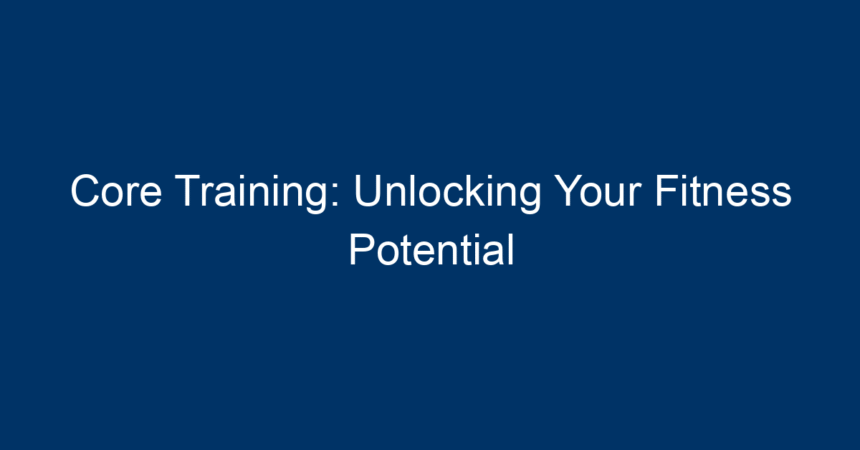In the world of fitness, one fundamental concept ties together strength, stability, and overall health: core training. Often overshadowed by flashy weightlifting and cardio routines, core training is the unsung hero of any fitness regimen. It not only enhances athletic performance but also protects your spine, improves posture, and boosts your day-to-day quality of life. This article will explore the importance of core training, its benefits, essential exercises, and how to effectively integrate it into your routine. Let’s dive deeper into unlocking your fitness potential through core training.
What is Core Training?
Core training refers to a variety of exercises aimed at strengthening the muscles in your abdomen, lower back, hips, and pelvis. These muscles collectively support your trunk and include the rectus abdominis, obliques, transversus abdominis, and erector spinae. While some might mistakenly believe that core training solely focuses on the abdominal muscles, it’s much broader, encompassing the entire torso.
Why is Core Training Important?
Understanding the significance of core training is crucial for anyone looking to enhance their fitness journey. Here are some compelling reasons:
-
Enhanced Performance: Whether you’re running, cycling, or participating in sports, a strong core is vital for optimal performance. It helps generate power and improve coordination.
-
Injury Prevention: A well-conditioned core stabilizes your spine and pelvis, reducing the risk of injuries during physical activities. It also helps in preventing lower back pain, which is a common issue for many individuals.
-
Improved Posture: Core training promotes better posture by strengthening the muscles that support your spine. This can lead to reduced pain and discomfort related to long hours of sitting at a desk.
- Functional Fitness: Everyday activities like lifting groceries, climbing stairs, or playing with children require a functional core. Core training prepares your body for these movements, making them easier and safer.
Core Muscle Anatomy
To fully grasp core training, it’s essential to know the muscles involved. Here’s a brief overview:
-
Rectus Abdominis: The "six-pack" muscle that runs vertically along the front of the abdomen, responsible for flexing the spine.
-
Transversus Abdominis: The deepest core muscle, wrapping around your torso like a corset, providing stability and supporting internal organs.
-
Obliques: These muscles are on each side of the rectus abdominis and assist in side bending and rotation.
- Erector Spinae: Located along your spine, these muscles are crucial for extending the back and maintaining an upright posture.
Essential Core Exercises
Integrating core training into your workout regimen doesn’t have to feel monotonous. Here are some effective exercises to enhance your core strength:
1. Planks
How to Do It:
- Lie face down on a mat. Lift your body up on your toes and forearms, ensuring a straight line from head to heels.
- Hold for as long as you can, focusing on engaging your core.
Benefits: Planks activate multiple muscle groups, improving stability and endurance.
2. Russian Twists
How to Do It:
- Sit on the ground with your knees bent. Lean back slightly while keeping your back straight.
- Hold a weight or your hands together, twist your torso to the right, then to the left.
Benefits: This exercise targets the obliques and improves rotational strength.
3. Dead Bug
How to Do It:
- Lie on your back with your arms extended toward the ceiling and legs raised at a 90-degree angle.
- Slowly lower one arm and the opposite leg towards the floor while keeping your core engaged, then return to the starting position.
Benefits: A fantastic exercise for improving coordination and core stability.
4. Bicycle Crunch
How to Do It:
- Lie on your back with your hands behind your head and legs raised.
- Bring one knee towards your chest while rotating your torso to bring the opposite elbow towards that knee. Alternate sides.
Benefits: This exercise is excellent for targeting both the upper and lower abs as well as the obliques.
5. Bird-Dog
How to Do It:
- Start on your hands and knees in a tabletop position. Extend one arm forward and the opposite leg back.
- Hold for a few seconds before switching sides.
Benefits: This exercise enhances stability and coordination while working the entire core.
How to Integrate Core Training into Your Routine
To maximize the benefits of core training, consider the following tips:
Frequency
Aim to incorporate core workouts 2-3 times a week. Consistency is key; even short sessions can yield results.
Mix it Up
Avoid boredom and plateaus by varying your exercises. Incorporate stability balls, resistance bands, or body weight to keep your workouts fresh.
Combine with Other Workouts
Integrate core exercises into your existing regimen. For example, add planks or Russian twists to your strength training or cardio routines.
Focus on Form
Proper form is crucial for effective core training. Always prioritize quality over quantity to prevent injuries.
Listen to Your Body
While it’s important to challenge yourself, pay attention to any signs of pain or discomfort. Modify exercises if needed and consult a professional for guidance.
Progress Tracking
Tracking your progress can be incredibly motivational. Consider keeping a fitness journal to log workouts, improvements, and how you feel throughout the process. Noticing improvements in strength and overall fitness will encourage you to stick with core training.
Common Mistakes to Avoid
While core training is straightforward, some common mistakes can hinder results or lead to injury:
-
Neglecting the Lower Back: Many people focus solely on the abs. Remember that lower back muscles are equally important for stability.
-
Poor Form: Ensure you maintain proper form to avoid unnecessary strain on your back or other muscles.
- Overtraining: Like any muscle group, your core needs rest to recover. Avoid excessive training to prevent fatigue and injuries.
Conclusion: Unlock Your Fitness Potential
Core training is not just an aesthetic pursuit; it’s a foundational element that unlocks your fitness potential. By understanding the importance of a strong core, incorporating essential exercises, and following best practices, you can enhance your overall performance, prevent injuries, and improve your quality of life.
Actionable Insights:
- Set Goals: Determine specific core training goals, whether it’s to hold a plank longer or perform more repetitions.
- Find Resources: Consider enrolling in a core-focused fitness class or utilizing online resources for guided workouts.
- Stay Engaged: Make core training enjoyable by mixing in fun challenges or workouts with friends.
Embrace core training as a vital component of your fitness journey and watch as it transforms not only your strength but your overall well-being. Start today, and unlock your full potential!




